From inside (document excerpt):
Kickback may occur when the nose or tip of the guide bar touches an object, or when the wood closes in and pinches the saw chain in the cut. Tip contact in some cases may cause a lightning fast reverse reaction, kicking the guide bar up and back towards the operator. Pinching the saw chain along the top of the guide bar may push the guide bar rapidly back towards the operator. Either of these reactions may cause you to lose control of the saw which could result in serious personal injury.
Section 5.12 of ANSI B 175.1-1991 sets certain performance and design criteria related to chainsaw kickback. STIHL has developed a color code system using green and yellow to help you select a powerhead, bar and chain combination that complies with the kickback requirements of the ANSI Standard. See the sections entitled “Safety Precautions ” and “Specifications ” of this manual. Do not rely exclusively upon the safety devices built into your saw. As a chainsaw user, you should take several steps to keep your cutting jobs free from accident or injury. 1. With a basic understanding of kickback, you can reduce or eliminate the element of surprise. Sudden surprise contributes to accidents. Keep a good firm grip on the saw with both hands, the right hand on the rear handle, and the left hand on the front handle, when the engine is running. Use a firm grip with thumbs and fingers encircling the chainsaw handles. A firm grip will help you reduce kickback and maintain control of the saw. Don’t let go. Make sure the area in which you are cutting is free from obstructions. Do not let the nose of the guide bar contact a log, branch, or any other obstruction while you are operating the saw. Cut at high engine speeds. Do not overreach or cut above shoulder height. continued on the back inside cover 6. Follow manufacturer’s sharpening and maintenance instructions for the saw chain. Only use replacement bars and chains specified by the manufacturer or the equivalent. Reduced kickback bars and low kickback chains are designed to reduce the risk of kickback injury. Ask your STIHL dealer about these devices. 7. 8. 2. % 2WKHU 6DIHW 3UHFDXWLRQV 1. Do QRW operate a chainsaw with one hand! Serious injury to the operator, helpers, bystanders, or any combination of these persons may result from onehanded operation. A chainsaw is intended to be used with two hands. Do not operate a chainsaw when you are fatigued. Use safety footwear; snug-fitting clothing; protective gloves; and eye, hearing, and head protection devices. RQWHQWV Main Parts of Saw Definitions Safety Precautions – The Operator – The Saw – The Use of the Saw – Maintenance, Repair and Storing Mounting the Bar and Chain Tensioning the Saw Chain Fuel Mix Fueling Chain Lubricant Fill Chain Oil Tank Chain Brake – Locking saw chain – Releasing chain brake – Checking operation – Chain brake maintenance Information Before You Start Starting the Saw Checking Chain Lubrication Oil Quantity Control During Break-in Period During Operation After Finishing Work Air Filter System.


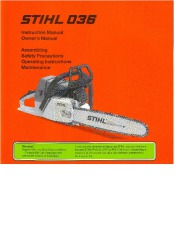 STIHL Owners Manual - 1 of 56
STIHL Owners Manual - 1 of 56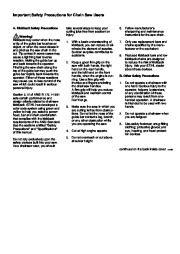 STIHL Owners Manual - 2 of 56
STIHL Owners Manual - 2 of 56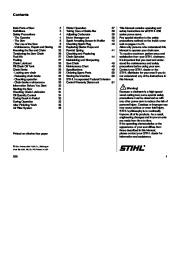 STIHL Owners Manual - 3 of 56
STIHL Owners Manual - 3 of 56 STIHL Owners Manual - 4 of 56
STIHL Owners Manual - 4 of 56 STIHL Owners Manual - 5 of 56
STIHL Owners Manual - 5 of 56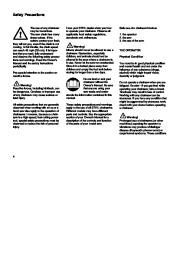 STIHL Owners Manual - 6 of 56
STIHL Owners Manual - 6 of 56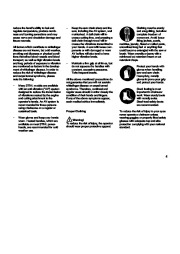 STIHL Owners Manual - 7 of 56
STIHL Owners Manual - 7 of 56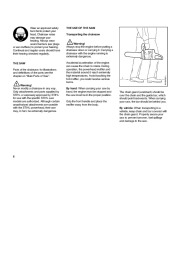 STIHL Owners Manual - 8 of 56
STIHL Owners Manual - 8 of 56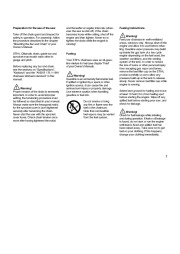 STIHL Owners Manual - 9 of 56
STIHL Owners Manual - 9 of 56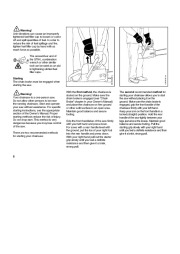 STIHL Owners Manual - 10 of 56
STIHL Owners Manual - 10 of 56